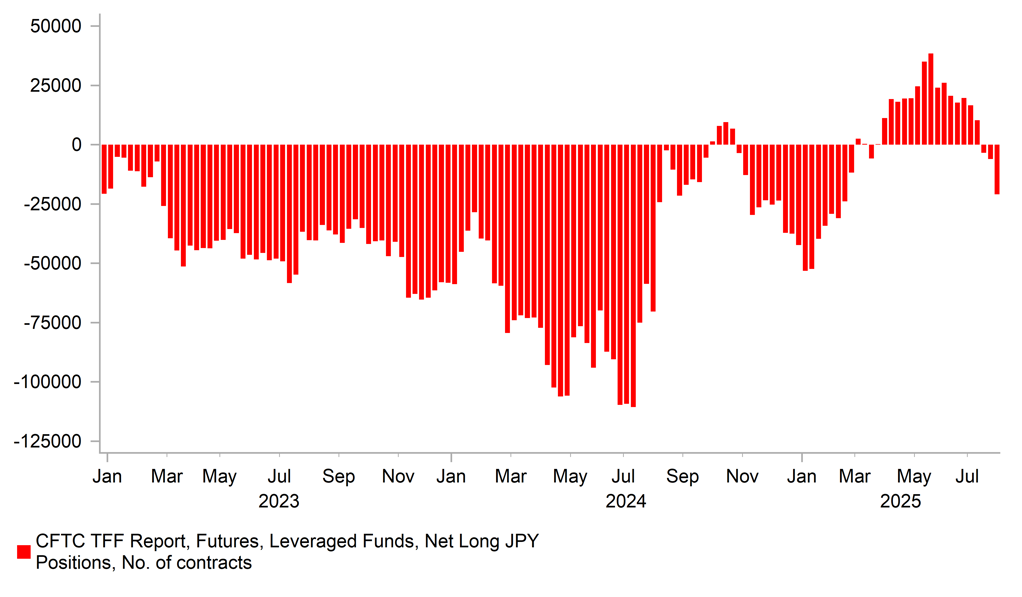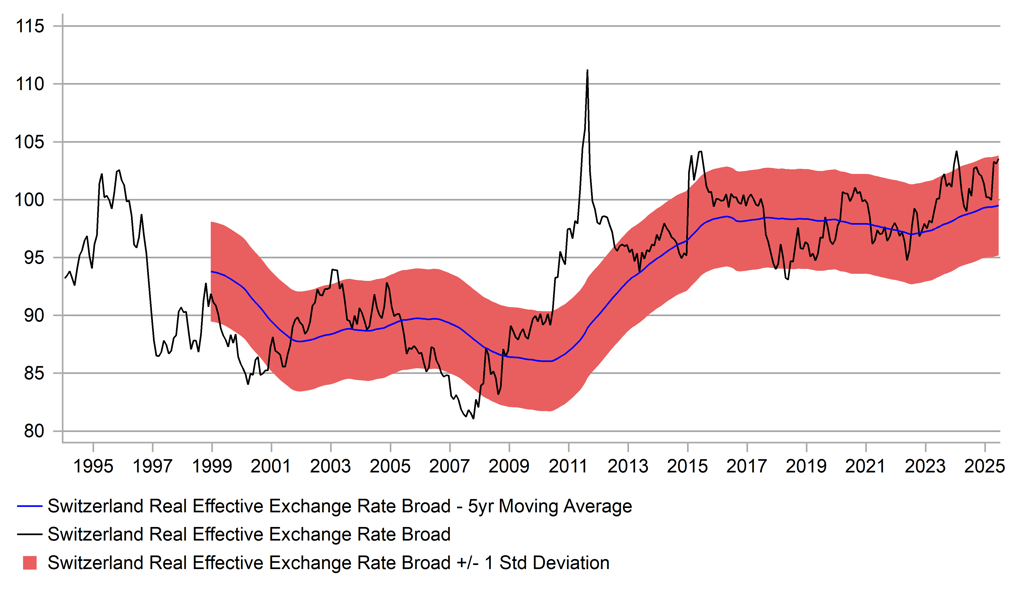Weak JGB auction and political risks highlight downside yen risks
JPY: BoJ pressure to hike could build
The yen is broadly stable after advancing sharply versus the US dollar following the much weaker than expected US jobs data on Friday. Since the close on Thursday, the yen is by some distance the best performing G10 currency, advancing by around 2.5%. The yen on Thursday had weakened sharply in the aftermath of what was a dovish press conference from BoJ Governor Ueda after the BoJ left rates unchanged and failed to provide any explicit guidance on the prospect of a rate hike.
The minutes from the previous meeting before last week’s were released today and understandably at that time in June the ability to provide clarity on policy direction was difficult given the uncertainty related to trade. The minutes did show that in the scenario of trade uncertainties de-escalating, the BoJ would consider a rate hike. While trade uncertainties have not fully de-escalated, and probably never will, the outlook is certainly a little clearer and while the yen has strengthened due to the jobs data, the broader market conditions have not been disrupted by the trade deals and tariffs agreed. This could well result in building pressure on the BoJ to consider a rate hike if of course there is no further substantial strengthening of the yen which would certainly alleviate inflation concerns.
The pressure to hike could also come from a wish to help support and stabilise the JGB market. Today, a 10-year JGB auction indicated weaker demand with the bid-to-cover at 3.06, below 3.51 at the last auction and the 12-month average of 3.17. The tail came in wider at 0.14 as well compared to 0.03 at the last auction. The minutes from the June BoJ meeting also included comments expressing concern over market stability by cutting JGB purchases too quickly. JGB yields are lower still today in part on increased expectations of weaker global growth due to Trump’s tariffs and the weak US jobs data and the stronger yen. But domestically Japan remains where inflation risks look more elevated, especially given the limited appreciation of the yen.
But JGB market instability remains a downside risk for the yen. PM Ishiba yesterday hinted at the possibility of another fiscal stimulus package. Questioned in the Diet on the issue PM Ishiba stated he would consider tax cuts and additional spending if required and after consulting opposition parties. Given the main opposition parties ran Upper House election campaigns on increasing fiscal spending to help households, another fiscal spending plan seems likely. The size and whether additional JGB issuance would be required will be important. But even if no additional issuance is required it still could unsettle the JGB market and bring back appetite to sell the yen. The broader US dollar performance is certainly more impressive than expected given the 28bp plunge in the 2-year UST note yield on Friday that points to a market that is still working through the liquidation of short dollar positions. Given the outperformance of JPY, the build-up of short JPY positions may well now be largely cleared.
JPY HAS OUTPERFORMED IN G10 AS RECENT SHORTS ARE LIQUIDATED

Source: Bloomberg, Macrobond & MUFG GMR
CHF: Switzerland in the spotlight
The Swiss franc was the fourth best performing G10 currency in the first half of the year as the US dollar sold off more broadly despite the fact that the SNB cut rates back to zero percent in June with evidence of much stronger than expected disinflationary pressures. As has been the case in the past, the SNB underestimated the speed of decline in annual inflation and the slower than required pace of easing leaves the SNB at risk of being behind the curve.
That risk is now that bit higher following the huge 39% tariff imposed on US companies importing from Switzerland. The rate is far higher than across the rest of Europe and other major developed economies and the government is eager to address what they view as inconsistency. Karin Keller-Sutter, the President of Switzerland and the Finance Minister came in for heavy criticism over the weekend and is under intense political pressure to address the very high tariff rate. But Switzerland was likely seen by the Trump administration as being in a very weak position. Across the G10 space, goods exports as a percentage of GDP are extremely high at around 40% and then exports to the US as a percentage of total exports are also relatively high at 16.5%. This implies in GDP terms, export exposure to the US runs at about 6.5%. Apart from Canada, that’s in fact the highest exposure to the US amongst G10 countries. Switzerland’s key industries will be hit significantly with pharmaceuticals; precious metals; clocks and watches; medical equipment and machinery the top five categories.
Without a deal being reached and the tariff reduced, Switzerland will likely see weaker GDP growth and inflation ahead. The SNB expects real GDP growth of 1.0%-1.5% in both 2025 and 2026 which results in inflation forecasts of 0.3% in Q4 2025; 0.6% in Q4 2026 and 0.7% in Q4 2027. Those will likely be too high with GDP set to take a hit on the back of these higher tariff rates sticking. Yesterday, CPI data was released and was a little higher than expected at 0.2% in July, up from 0.1% and compared to an expected 0.1%. The core rate accelerated to 0.8%. The PMI Services Index plunged from 48.5 in June to 41.8 in July, the sharpest drop since covid in 2020.
The SNB has previously expressed some reservations on re-entering a negative policy rate but that will be much more likely if no deal is reached to alter the tariff. The franc is underperforming but the real policy rate is unlikely to be low enough to trigger any sustained depreciation and there is likely to be renewed demand at weaker levels especially if a risk-event emerges in circumstances of still relatively high global inflation (meaning the yen fails to take on a safe-haven role). Even with low inflation and now a zero policy rate in Switzerland, the BIS real effective exchange rate has advanced and is close to highs reached over the last ten years. The SNB effective policy rate has turned negative and the OIS market shows a policy rate of -0.20% by March 2026.
CHF REER CLOSE TO HIGH RECORDED OVER LAST 10YRS

Source: Macrobond; Bloomberg & MUFG GMR
KEY RELEASES AND EVENTS
|
Country |
BST |
Indicator/Event |
Period |
Consensus |
Previous |
Mkt Moving |
|
IT |
08:45 |
Italian Composite PMI |
Jul |
-- |
51.1 |
! |
|
IT |
08:45 |
Italian Services PMI |
Jul |
52.5 |
52.1 |
! |
|
FR |
08:50 |
French S&P Global Composite PMI |
Jul |
49.6 |
49.2 |
! |
|
FR |
08:50 |
French Services PMI |
Jul |
49.7 |
49.6 |
! |
|
GE |
08:55 |
German Composite PMI |
Jul |
50.3 |
50.4 |
! |
|
GE |
08:55 |
German Services PMI |
Jul |
50.1 |
49.7 |
! |
|
EC |
09:00 |
S&P Global Composite PMI |
Jul |
51.0 |
52.0 |
!! |
|
EC |
09:00 |
Services PMI |
Jul |
51.2 |
50.5 |
! |
|
UK |
09:30 |
Composite PMI |
Jul |
51.0 |
51.0 |
!!! |
|
UK |
09:30 |
Services PMI |
Jul |
51.2 |
51.2 |
!!! |
|
EC |
10:00 |
PPI (YoY) |
Jun |
0.5% |
0.3% |
! |
|
EC |
10:00 |
PPI (MoM) |
Jun |
0.9% |
-0.6% |
! |
|
US |
13:30 |
Trade Balance |
Jun |
-62.60B |
-71.50B |
!! |
|
CA |
13:30 |
Trade Balance |
Jun |
-5.80B |
-5.90B |
! |
|
US |
14:45 |
S&P Global Composite PMI |
Jul |
54.6 |
52.9 |
!! |
|
US |
14:45 |
Services PMI |
Jul |
55.2 |
52.9 |
!! |
|
US |
15:00 |
ISM Non-Manufacturing Index |
Jul |
51.5 |
50.8 |
!!! |
Source: Bloomberg & Investing.com
